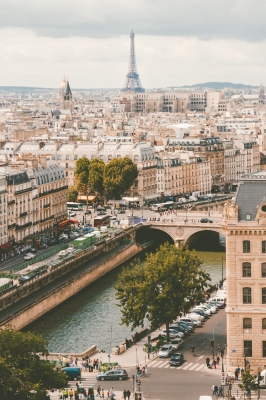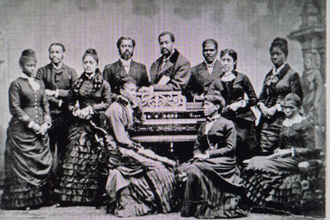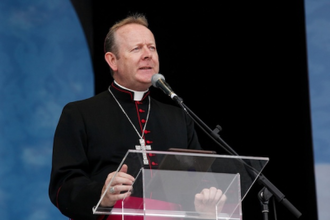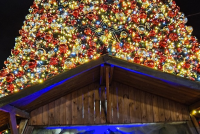Paris Springtime

Photo by Ilnur Kalimullin on Unsplash
Oh to be in Paris, now that Springtime's there.
What a joy to be back in the City of Light! The candelabras out on the chestnut trees lining the quais of the Seine, and toute la jeunesse revelling in flânerie along the riverside. A grey wagtail, the 'water wagtail', dancing up into the air to catch insects to feed her importunate fledgling. Impressions a-gogo, a feast for the senses.
Right now, there is some sad, commanding street theatre right in Paris's heart. The Palais de Justice on the Ile de la Cité is hosting the trial for the terrorist atrocity in the Bataclan Nightclub perpetrated in 2015. Baffled walkers find their paths blocked when the court is in session by the redoubtable CRS, French riot police who look for all the world like the marionnettes from Thunderbirds. The intention surely is for the State to demonstrate its reassuring might.
Just a two-minute walk away, the Church does not project any such stability. The splendid gothic Cathedral of Notre Dame remains propped up by a forest of scaffolding after the fire of 2019. The aim is for everything to be restored by 2024 when Paris hosts the Olympic Games.
At the other end of the Ile de la Cité, in the middle of the Pont Neuf, is an equestrian statue of Henri IV known as Le Vert Galant (the nickname of this notorious womaniser). He it was who led the Protestant Huguenots and married Marguerite de Valois in Notre Dame. Just a few days later, several of his most powerful allies were assassinated in the Massacre of St Bartholomew's Day, perpetrated by the Catholic League. Many bodies were dumped into the Seine.
Henri later converted to Catholicism to ascend the French throne, famously remarking, 'Paris vaut bien une messe' [Paris is well worth a Mass].
Just below Henri on his horse is the site where the Grand Master of the Knights Templar, Jacques de Molay, was burned at the stake in 1314 on the orders of King Philippe le Bel. This medieval king liked to flex his muscles and increase his power and wealth. He put up a new city wall around Paris. The Templars were a very rich order. He wanted their money. But within the year of Molay's roasting, the king too had shuffled of this mortal coil.
The central positions of the Palais de Justice (also the Parlement of the Ancien Régime) and Notre Dame demonstrate their centrality as foundational pillars of the French Royal State: 'Une foi, une loi, un roi,' as the saying went.
Church and State parted official company in 1905 with the foundation of l'Etat laïcque (secular state). This sundering notwithstanding, many rightwing nationalists involve the Church in their traditionalist identity politics, just as there is a leftist tradition of a Social Catholicism within France.
What is undeniable is the imprint of the Church and accompanying Christian culture everywhere throughout Paris and the nation.
Standing opposite Le Vert Galant statue on the rive droite of the Pont Neuf is the elegant La Samaritaine building - so named because there used to be a well close by with a statue of the Samaritan woman at the well by its side.
On the rive gauche meanwhile, it's just a five minute stroll from Le Vert Galant into the heart of the Latin Quarter (so called from the time when all the students spoke Latin as the international lingua franca). The Sorbonne is here, dating back to the Thirteenth Century, and possibly my favourite church in Paris, St Séverin, with its elegant grove of pillars forming a beautiful déambulatoire around the central altar.
There are wholesome liturgies here with good cantors. One interesting thing of note: whereas in England and Wales, there is clear guidance when to stand, sit and kneel, vive la différence seems the watchword in many French churches. The general practice used to be to stand throughout the Eucharistic Prayer. Now there are a fair few ostentatious kneelers (though they don't all kneel for the same length of time). This positioning could also be interpreted as ideological. Amusingly for les British, the current PP is a certain Guillaume le Normand. If anyone wishes to go to Paris for Christmas, St Séverin has an open house for a very convivial lunch after the Midday Mass. Guillaume le Normand's pièce de résistance is actually boeuf bourguignon.
In recent years, the Archdiocese of Paris has reopened the Cistercian order's glorious Gothic medieval HQ, known as the Collège des Bernardins, as a site of vigorous contemporary learning in the Latin Quarter. Right now, it is housing a fascinating exhibition on the history of the construction and rich, eventful history of Notre Dame. Equipped with a tablet, you zap your way around inside and are treated to: panoramas of the medieval construction site presided over by Archbishop Sully; an unravelling of the symbolism of the rose window; immersion into the world of the itinerant masons, smiths and all the other highly skilled artisans who built these gothic treasures. Old maps become three-dimensional and you can hover over the marriage between Henri de Navarre and Marguerite de Valois, or muscle in on Napoleon's self-coronation. Poignantly, he founded the sapeurs-pompiers, from whom the present-day fire brigade - who saved Notre Dame - were spawned.
The Fondation Cartier is hosting France's first exhibition dedicated to the great Mexican photographer Graciela Iturbide (ends 29th May). Recipient of a Catholic education and brought up in a culture pulsating with festivals and religious representation, her work excels in recording and honouring the vitality and drama of popular ritual and religious culture in Mexico and beyond. A first-communicant sports a Death's Head in her white gown (roaming skull-masks and marauding Death are everywhere, including images of dead children in their cots). Another child dons angel-wings. A man's bare back bears the tattooed image of Our Lady of Guadalupe. A series of slaughtered lambs cannot but be Christological. Gang members pray and pose under images of Christ and Our Lady. Her portraits of strong women are superb and remind me of the imposing female presence to be found in Paula Rego's paintings. A picture taken in Ecuador, in 1972, shows an image of 'La Veronica, patrona de los fotógrafos'. The veiled bearer of the 'true picture' is between two religious sisters and is full of a silent power and authority. Another photo from Iturbide's own home juxtaposes two small figurines: one is the body of St Sebastian, shot through with arrows; the other is of a photographer, riddled with bullets. Truth costs and so does the courage to record the truth. Glorious.
From the Fondation Cartier, a pleasant stroll through the haven of Montparnasse Cemetery brings you well on your way to the Rue du Bac and the Mother House of the Missions Etrangères de Paris (MEP). An exhibition about the 360-year old MEP is a revelation. Too often we have sad cause to rue the disguising of colonial abuse through the cloak of evangelisation. But here, it appears, was real idealism and altruism. Most of the priests of the 'Foreign Missions' went to Asian countries where there was no French colonial presence. The Catholic Faith was rarely authorised and often banned. Tolerance alternated with persecution. From the Eighteenth Century to today, over 200 MEP priests have died violent deaths in the exercise of their mission. A Martyrs' Hall records this poignant history with arresting relics. What is heartening, however, is the evidence of sensitive intercultural dialogue, and a record of devotion to 'Kingdom' values in education, health and solidarity. Vietnamese Stations of the Cross are currently inside the MEP's Chapel of the Epiphany and there is a temporary exhibition recording the MEP's bumpy 350-year presence in Thailand (L'Evangile au Pays du Sourire, until 30th June).
Another highly welcome new acquaintance was Louis-Léopold Boilly, a prodigious painter of Paris (Musée Cognacq-Jay, until 26th June). An auto-didact of rare talent, Boilly chronicled Parisian life from one revolution (1789) to another (1848) with satirical glee and verve, often depicting himself in his work, and producing a gamut of grotesques and caricatures. However, he could produce sober work too, and arresting trompe l'oeils of a rare virtuosity. One such of a crucifix is more a celebration of the artist than a testament of piety. La Prison de Madelonnettes (c. 1815-19) takes as its subject matter the women's prison installed since 1795 in the former convent of the Daughters of Mary Magdalen known as Madelonnettes. Membership of the order was reserved for repentant sex-workers. (Cf the 'Magdalen Laundries' in Ireland. Centuries of misrepresentation of Mary of Magdala coupled with misogyny.) The work conveys a monumental dramatic quality in a play of theatrical light and shade. On the sunny side, women prisoners or visitors chat and banter with the guards, while in the shadows, inmates carry out their dreary labour. A guard who faces away from us points into the shade as if to warn of the prisoners' sorry fate.
Further current highlights include the religious and carnivalesque illustrations of the Seventeenth-Century artist and printmaker Jacques Callot at the Fondation Taylor; a celebration of women artists in the Paris of the 1920s (Pionnières: Musée de Luxembourg; note the marionette saints and religious plays here); and an exploration of Delacroix and Nature in the Musée Delacroix (which includes the paintings Mary Magdalene in the Desert and The Education of the Virgin).
One unwelcome tradition that has encrusted itself in recent years is the practice of les couples amoureux to affix a padlock to a hapless piece of street or river furniture in a ritual of monogamy. Things became so bad that the Pont des Arts was in danger of being weighed down by all the padlocks. (Furthermore, the keys are thrown into the Seine with callous disregard for the environment). These were removed and the Pont's railings covered in PVC sheeting. However, the padlocks proliferate like cancer cells along the quais wherever they can be affixed. A tedious business but it's hard to remain downcast for long in the City of Light.


















